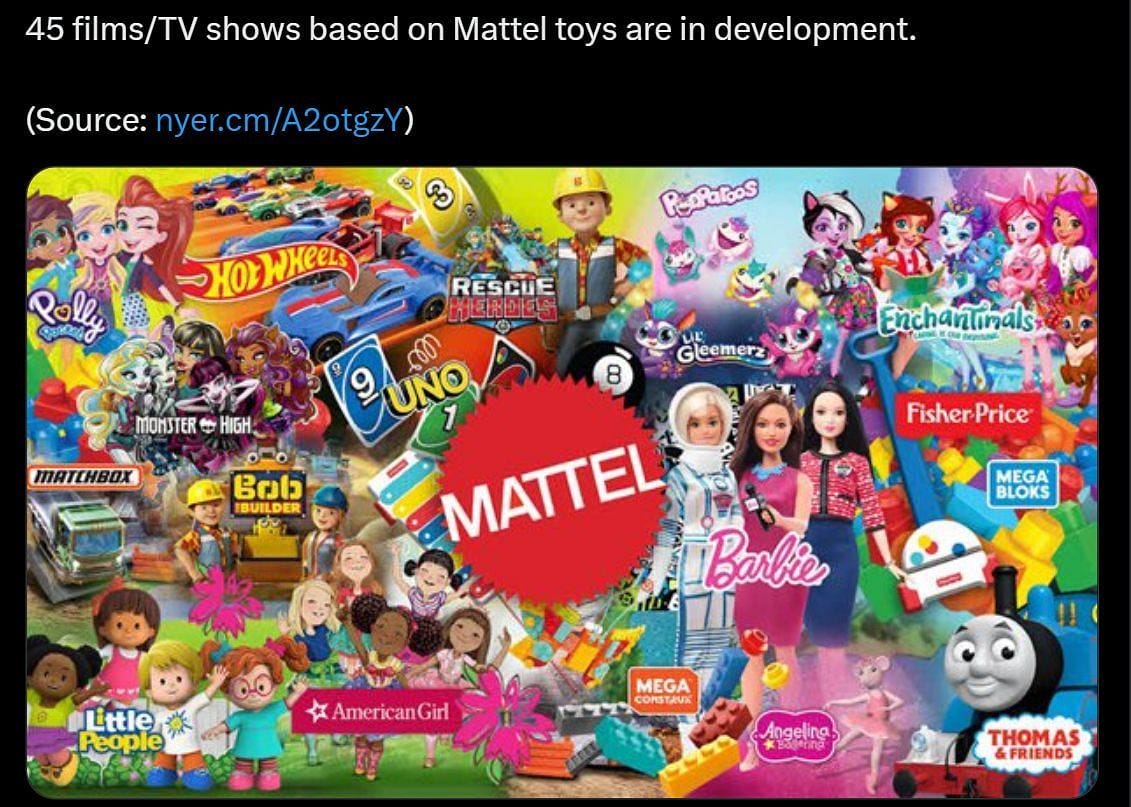Will Barbie be Mattel's Ironman?
As the Barbie movie hits the theatres, we take a look at Mattel's strategy and why they desperately need the movie to succeed.
If you haven’t been bombarded by Barbiecore on social media nor seen the brightly colored selfies nor the mugshot redraws, where have you been? you’ve been blessed.
👋 Welcome to tbh.finance. Here, we write about stocks, ETFs and finance honestly. If you enjoy today’s article, do subscribe to receive more like this in your inbox.
If you’re not familiar, Mattel is a toy manufacturer that distributes popular brands like Hot Wheels, Fisher-price, UNO and the toy I had always wanted as a child but never gotten:
Digressions aside, one of Mattel’s top brands is Barbie.
“Life in Plastic, it’s fantastic!” 💁♀️
Barbie was launched in 1959. It was modeled after a risqué gag gift for men.
Fact: Barbie attracts controversy 😈
Right from launch, Barbie was controversial for its curvy body figure and unrealistic body image. I mean, what did you expect if you model a doll after a risqué gag gift right?
Mattel decided to sell the doll to children. And although mothers complained about the body figures of Barbie dolls, they didn’t seem hesitant when it came to buying these toys for their children. Mattel sold selling about 100,000 dolls in the first year of Barbie’s launch.
Over the years, people complained about materialism that’s been linked to the Barbie brand; the doll came with accessories from clothes to cars to houses.
And in recent years, Barbie was also targeted by the woke community for its lack of diversity. Mattel circumvented this by introducing dolls with a variety of body shapes and races.
Barbie losing her sparkle 🌟
In the 1950s, Barbie showed a generation of girls that they could be financially independent and self-sufficient.
“Barbie always represented the fact that a woman has choices.” – Ruth Handler, Creator of Barbie, co-founder of Mattel.
Barbie stood out in a market where dolls were mostly in the image of babies. And with its empowering message, it managed to capture a strong market.
However, we have come a long way since the 1950s and Barbie has been losing her sparkle. Sales had been dropping since 1997:
Although sales did pick up in 2015, it didn’t last and sales started falling rapidly in 2020.
That said, Barbie continues to drive a significant portion of toy sales for Mattel and is one of the company’s key brands.
The Barbie movie isn’t just going to move doll sales 👀
You may think that Mattel’s aim with the Barbie movie is to boast Barbie sales.
But Mattel has bigger plans. ✨
Doll sales aside, Mattel will pocket some revenue from the box office (although terms of its deal with Warner Brothers Studio have not been disclosed).
In line with the movie, Mattel has worked out licensing deals to flood the market with Barbie-related merchandise. These include Barbie T-Shirts by Gap, Barbie platform sneakers by Sugerga, Barbie handbags by Balmain, Barbie pool floats at Target and Amazon, to even a Barbie Xbox from Microsoft.
On top of merchandise, hype has been building up for the movie which is due for public release on 21st July.
Barbie’s Malibu DreamHouse being listed in AirBnB. Social media had also been swarmed by a pink Barbiecore wave that even Her Royal Highness Kate Middleton couldn’t ignore.
Mattel is definitely not leaving the success of the Barbie movie to chance.
Here’s why:
Mattel needs to save its business 🦺
Mattel is currently the 6th largest toy market in the world.
Sounds great, right?
Well…Mattel (NASDAQ: MAT) used to be the largest toy maker, by revenue. They had lost their top spot to the Lego Group in 2016. ❌👑❌
In a digital age where kids are more proficient browsing YouTube, swiping TikTok and hanging out with friends on Roblox, Mattel has been feeling the heat.
And this shift has been reflected in Mattel’s books. 📉📉📉
The company has been struggling to grow and sales have been on a steady downtrend.
Mattel’s plan to turn its business over?
“Let’s digitize our toy box!” 🎞️
Mattel is taking a leaf out of Marvel’s book.
Marvel Cinematic Universe (MCU) is a shared universe consisting of characters from Marvel Comics. Marvel announced the first film franchise in the MCU back in 2005, releasing Iron Man as the first MCU movie in 2008.
This move transformed Marvel from a struggling film company into one of the world’s biggest movie franchises, raking in over $28B in revenue as of 2022.
Mattel looks to set foot in the same direction, starting with Barbie.
Mattel’s Cinematic Universe 🚂💄🏎️
Barbie is just Mattel’s first step into the movie world. And the company is committed to building its own “MCU”.
According to reports, Mattel has around 45 toy-related films in development, some of which includes IPs like Barney (which promises to be “adult oriented” and to “lean into millennial angst” #cantwait), Hot Wheels, Polly Pocket, He-Man, and more.
Thus far, Mattel’s business had solely been on the sales of toys and games. The move to expand into films could allow the company to unlock a wider market, capturing new customers who would otherwise never spend a dime with Mattel.
However, the success of Mattel’s expansion would rely heavily on its ability to execute on its plans.
And the very first indicator of Mattel’s capability to execute will be out in a couple of hours.
So, would you be heading to the theatres to watch the Barbie movie?
👋Thanks for reading! tbh.finance writes about stocks, ETFs and finance honestly. If you enjoy today’s article, do share it with your friends.
If you hated it, hit reply and let us know!















